Learning how to understand and interpret the nutrition food labels can help you make healthier choices. CardioMender, MD provides insight into understanding food labels.
There has been lots of attention on the importance of getting enough protein to maintain optimal health, build muscle mass and control hunger. It is true that protein is essential for life, but more is NOT necessarily better. Or is it? Once again, the devil is in the details.
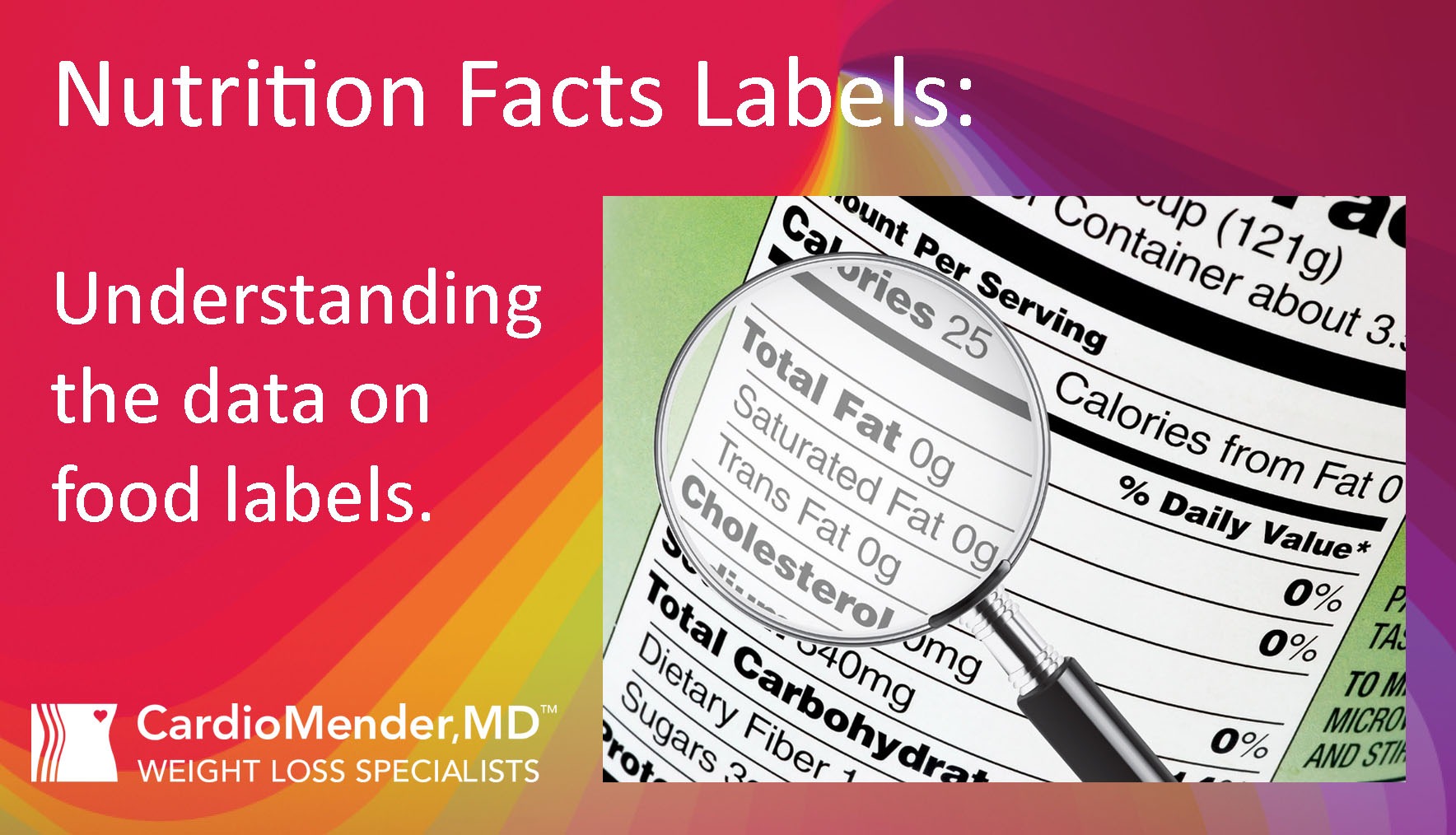
Protein
Many of us get an abundance of protein in our diet, so much so that the FDA does NOT require nutrition data labels to disclose the Percent Daily Value (%DV) of protein that a serving provides, although some labels do give this nutrition data. Two exceptions are foods represented as “high in protein” and foods intended for infants and children under 4 years old. According to the FDA, “Current scientific evidence indicates that protein intake is not a public health concern for adults and children over 4 years of age.”1
NOT all protein is the same.
The building blocks of proteins are amino acids, of which there are two basic types: those that our body can produce and those that it cannot. Essential amino acids are those that our body cannot make but are critical to maintaining optimal health and must be obtained through our diet. The easiest and most efficient way to ensure that we get enough of the full complement of essential amino acids is to eat protein derived from animal products, including meat. This can also be achieved by consuming a plant based diet, however this requires that we become knowledgeable and pay specific attention to ensure that all of the essential amino acids are provided by our choices in the proper amounts.
How much protein do we actually need?
The recommended daily allowance (RDA) is “the average daily dietary nutrient intake level sufficient to meet the nutrient requirements of nearly all… healthy adults”2. The RDA for protein is 0.8 g/kg body weight per day for mature adults. That means the protein RDA for a 170 pound adult is about 61.82 grams or 2.2 ounces of protein per day. This provides 247 calories per day. The Institute of Medicine recommends that adults should obtain 10-35% of their caloric intake from protein.2
The Nutrition Facts label gives the Percent Daily Value for most items, and provides a footnote which gives more detailed nutrition data for some of those items, based on a 2,000 or 2,500 calorie per day diet. The RDA and % Daily Value are closely related, however only the % Daily Value is given as nutrition data. More on this below.
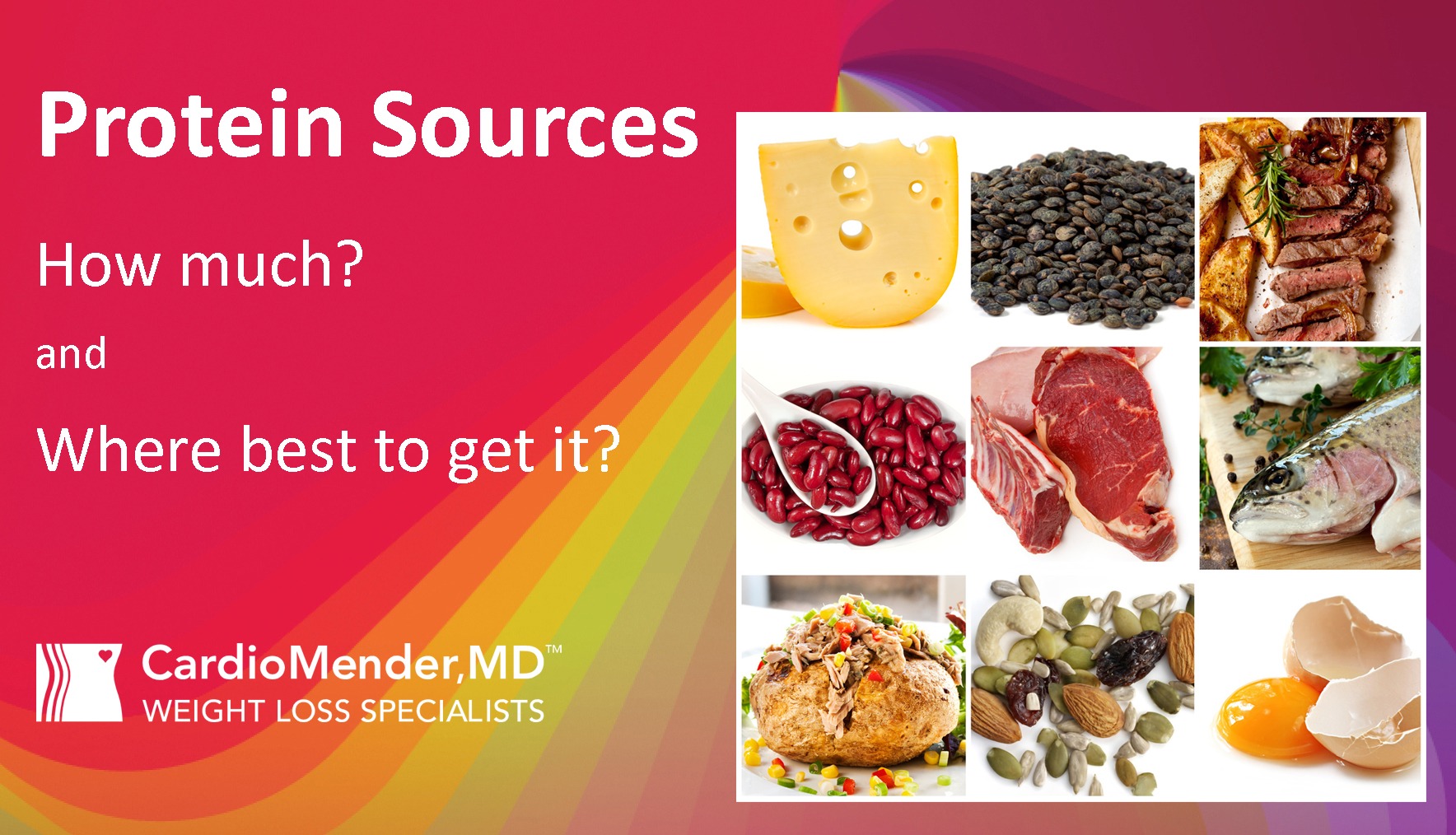
The reality:
Typically, most of us get the majority of our protein from meat or animal products. Keep in mind that there’s more than protein in meat, chicken, fish and pork, specifically saturated fat and cholesterol which carry potential adverse health consequences. Medical evidence has demonstrated that diets emphasizing animal sources of protein increase the risks of obesity, type-2 Diabetes Mellitus, cardiovascular disease and certain types of cancer compared to plant based diets.3
Diets that emphasize non-refined plant based foods inherently have less protein and saturated fat and are richer in essential nutrients such as fiber, vitamins, minerals and antioxidants that help maintain optimal health.
Increased Protein Diet and Weight Management:
In 2015 the American Journal of Clinical Nutrition published a comprehensive review article4 that concluded the following:
Higher-protein diets…provide improvements in:
- Appetite Suppression
- Body Weight Management
- CardioMetabolic risk factors reduction
- Feeling full after a meal (satiety)
- Weight Loss
- Fat mass loss
- Preservation of lean body mass
The article goes on to conclude “strategies to increase dietary compliance with long-term dietary interventions are warranted”.4
The Need for Balance
When it comes to protein, we must balance the potential benefits with the consequences of having too much animal protein.
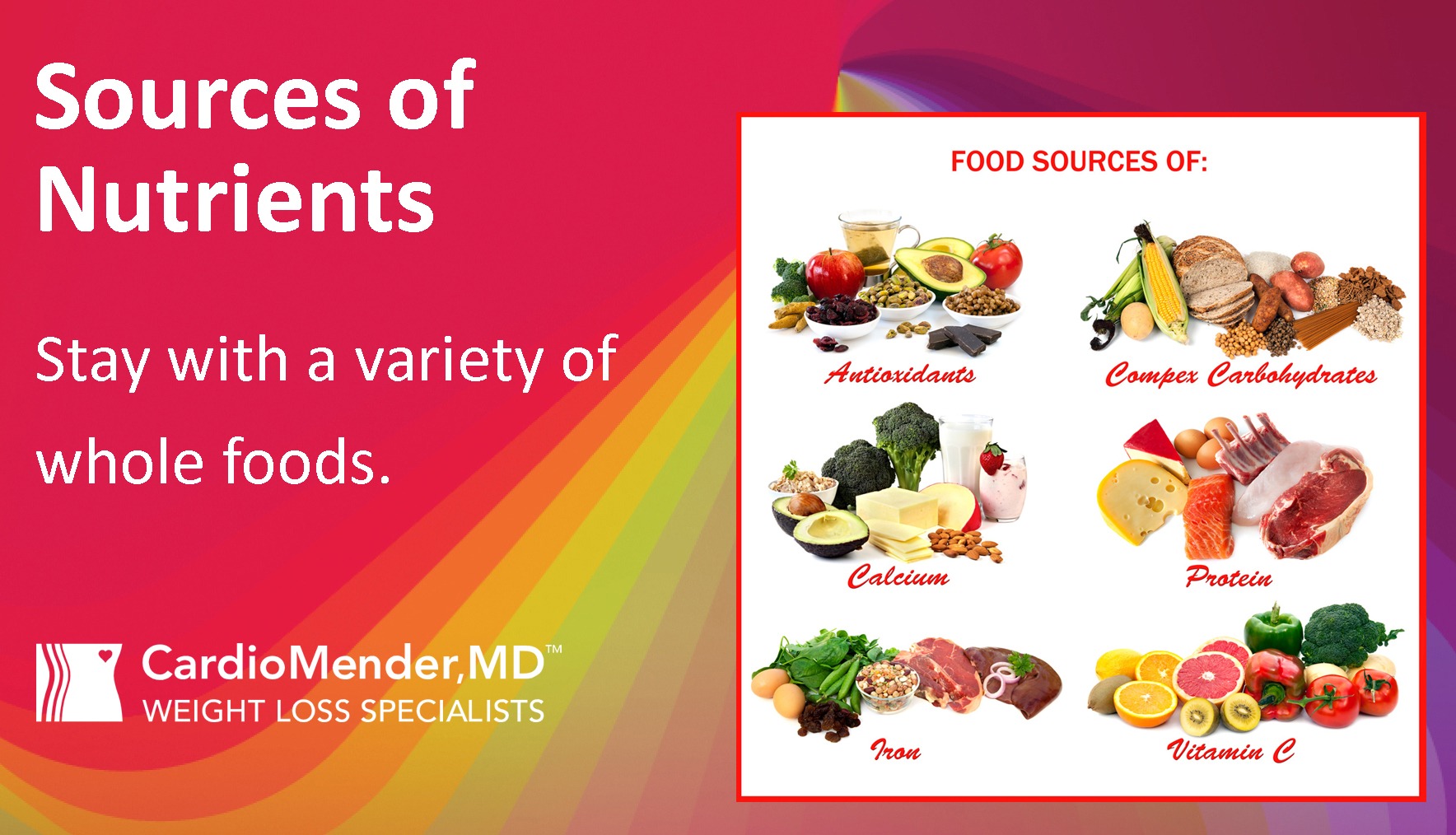
Vitamins and Minerals
Continuing down the Nutrition Facts label, select Vitamins and Minerals are listed after Protein. This section provides % Daily Value (%DV) of Calcium, Iron, Vitamins A and C in a serving, if we eat a 2000 calorie diet. In my opinion, this is an oversimplification of nutrition data that is of critical importance to supporting excellent health. There are many essential vitamins and minerals, critical to good health, which are not listed. This includes the B vitamins and minerals such as magnesium and manganese, as well as antioxidants, essential for maintaining optimal health.
The Percent Daily Value: %DV
The %DV values are located vertically adjacent to what FDA has designated as key nutrients on the food label. These percentages are NOT the relative amount in each serving, but rather the percent of the Recommended Daily Allowance achieved by eating one serving, assuming a 2,000 calorie per day intake. The %DV also helps us compare the relative amounts of nutrients from one food to another. When doing so, it is critical to establish that the serving sizes are similar between the foods compared!
FDA requires food manufacturers to list the recommended daily values (% DV) on food labels for certain nutrients and not others.
The %DV provides information about nutrients you want to get enough of and derive beneficial effects from. The %DV also provides information about nutrients you want to limit, such as saturated fats and cholesterol.
| Nutrients Requiring %DV | Nutrients NOT Requiring %DV |
|---|---|
| Total Fat | Trans Fat |
| Saturated Fat | Sugar |
| Cholesterol | Protein |
| Sodium | |
| Total Carbohydrates | |
| Dietary Fiber | |
| Vitamin A | |
| Vitamin C | |
| Calcium | |
| Iron |
Let’s discuss these nutrients not requiring the %DV to be listed; it is quite interesting.
Trans Fats
Experts cannot agree that ANY AMOUNT of trans fats in our diet is considered acceptable. As discussed in Part 1 of this article, FDA allows the food industry to falsely represent that there is zero trans-fat when the food contains less than a half gram per serving. When eating these foods, often we are unknowingly being exposed to foods that increase our risks of cardiovascular disease. Our exposure to the risks of trans fats are magnified when consuming multiple foods having less than a half gram per serving.
Sugar
Part 3 of this article dealt with sugar. No amount of sugar is required to maintain or sustain life. Its consumption has been linked to the obesity epidemic, type-2 Diabetes and many illnesses associated with a Western lifestyle. Despite this, there are no limits or recommendations on restricting its consumption.
Protein
Protein is the last of the nutrients for which the %DV is not required. As discussed above, proteins are made up of amino acids which are essential to maintaining health and are critical to ensuring a healthy metabolism, muscle mass and a host of other vital functions. In contradistinction to sugar, medical studies have demonstrated that protein can play a critical role in controlling hunger, facilitating weight loss and cardiometabolic risk reduction.4 As stated above, excess animal protein consumption, however, does carry health risks.
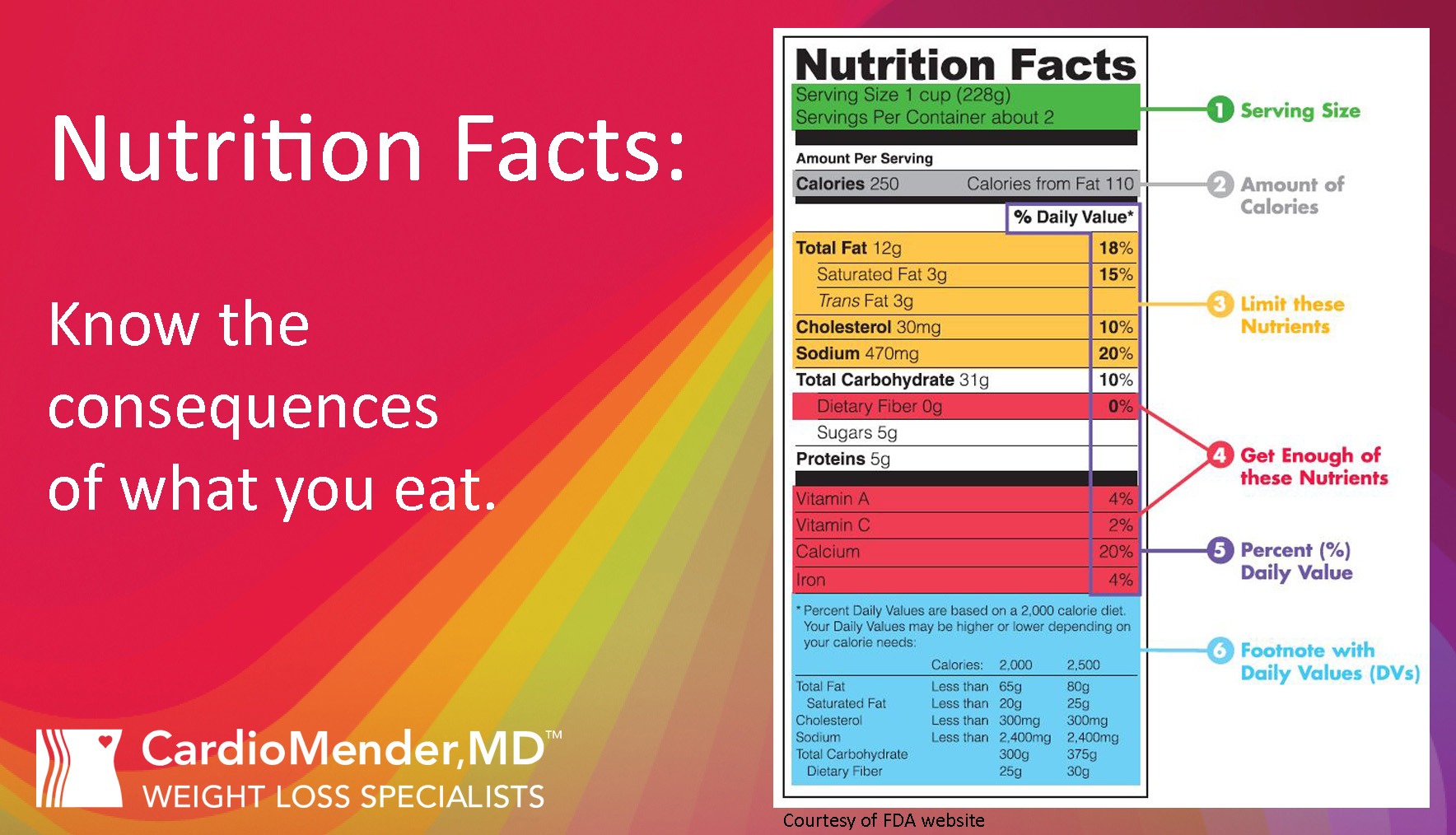
Nutrition Facts Footnote
The %DV section is followed by the footnote on the bottom of the Nutrition Facts label. It begins with an asterisk (*) which references that the %DV is based on a 2000 calorie diet.
The remaining part of the footnote section may be omitted for small labels. When present, it provides general nutritional recommendations for everyone, independent of individual needs and is identical from one product to the next.
Ingredients
All foods with the exception of fresh produce and seafood must provide a list of the ingredients on the food label in addition to the Nutrition Facts. Ingredients must be listed in descending order of predominance by weight. In other words, the ingredient weighing the most is listed first, and that weighing the least listed last.
Nutrition Data: Hiding the Truth
Of critical importance is understanding that there are many ways the food industry disguises things they don’t want us to know. One is the amount of added sugar, which can be disguised and underestimated when food producers add high fructose corn syrup, fruit juice including concentrate, sucrose, maltose, dextrose, honey or maple syrup to sweeten a food. They are listed separately but are equivalent to sugar. In order to get a better idea of how much sugar is actually added, add the contribution of each of these. To determine the total sugar, add the naturally occurring sugars found in all of the ingredients to the added sugar.
Another caution: Don’t stop reading after the first 3 or 4 ingredients. Often one of the ingredients used to make a food is manufactured with sugar. These are listed in parentheses. As you can see in this example, many of the components of the ingredients are sugar.
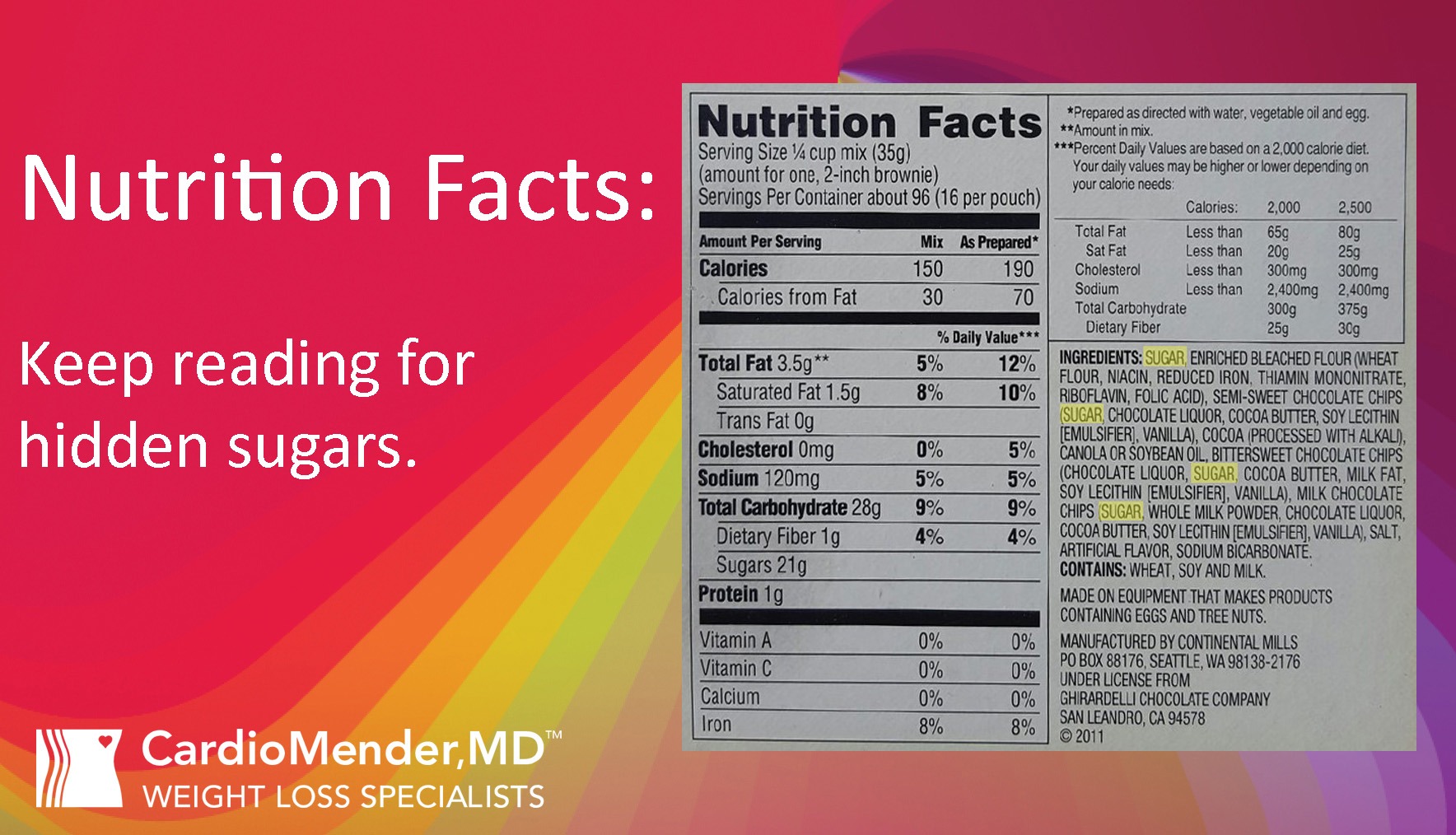
Finally, there are other items included in the Ingredients, including spices, preservatives and my favorite, ‘flavor enhancers.’ Many of the ‘flavor enhancers’, in my opinion, are nothing more than chemicals with drug-like effects. Food producers often employ food engineers that use ‘flavor enhancers’ as well as other ingredients including sugar, to tickle what they refer to as our ‘bliss point’. The goal is to provide foods with optimal appeal and create maximum craving. The end result, we eat more than we would have, had these flavor enhancers or sugar not been present. This maximizes both corporate profits AND our waistlines.
Recommendation: Take the Time to Read and Understand the Nutrition Data. You owe it to yourself.
My suggestion is to take the time to read and understand the ingredients and Nutrition Facts label when selecting a food. It is critical to know the consequences of the various components of the nutrition data on the food label. Be wary of foods containing unfamiliar ingredients. As a general rule, avoid food choices that have more than 4 or 5 ingredients. This can be a tedious process; the food industry preys on us having a shortage of time so they can provide us ‘quick fix’ solutions that often contribute to overeating and eventual health issues.
Suggestions:
- Select whole foods with a single ingredient or
- Choose foods with no more than 4 or 5 ingredients
- Understand the implications of the ingredients and nutrients in the food. Avoid foods that contain ingredients you don’t know or are not found in your pantry
- Shop the periphery of the supermarket which features less processed and more whole foods
- Avoid shopping when you are hungry
- Avoid shopping when you are short on time
- Avoid impulse buying especially when sampling food in the grocery store
- Keep in mind; we really are what we eat
You’ve Got to Live It!
Hopefully this series of articles helped clarify the information found on the Nutrition Facts labels, and you know have the knowledge to read between the lines and better understand exactly what you are eating. Use this article, Part 4, in conjunction with Part 1: Interpreting Nutritional Labels – Improve Your Understanding, Part 2: How Food Labels Show Minerals and Carbohydrates, and Part 3: What are Glycemic Index and Net Carbs? Reading Between the Lines, for better insight into Nutrition Facts food labels, nutrition data and the food you eat.
References:
1. http://www.fda.gov/Food/IngredientsPackagingLabeling/LabelingNutrition/ucm274593.htm
2. Institute of Medicine, Food and Nutrition Board. Dietary Reference Intakes for energy, carbohydrate, fiber, fatty acids, cholesterol, protein and amino acids. Washington (DC): National Academies Press; 2002.
3. The China Study T. Colin Campbell, Thomas M. Campbell II, a physician. BenBella Books; Published January 2005 USA
4. Leidy HJ, Clifton PM, Astrup A, Wycherley TP, Westerterp-Plantenga MS, Luscombe-Marsh ND, Woods SC, Mattes RD. The role of protein in weight loss and maintenance. Am J Clin Nutr 2015;101 (Suppl):1320S–9S. http://ajcn.nutrition.org/content/101/6/1320S.long






